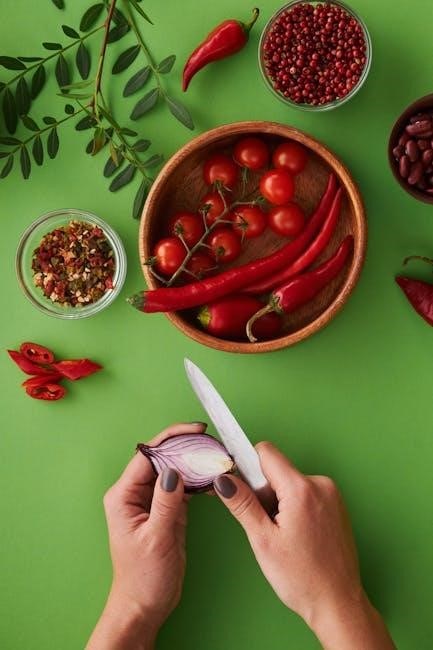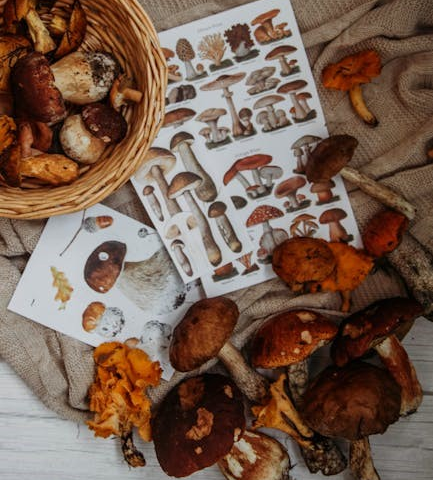Onions are a fundamental ingredient in global cuisine, adding flavor and texture to countless dishes. Their versatility, nutritional value, and cultural significance make them a kitchen staple worldwide.
What Are Onions?
Onions are bulbous vegetables belonging to the Allium family, characterized by their layered, papery skin and pungent flavor. They are widely cultivated and used in various culinary traditions worldwide. Onions come in different colors—yellow, white, red, and sweet varieties—each offering unique taste profiles. Their structure consists of concentric rings that can be used raw or cooked, adding depth to dishes. Beyond their culinary role, onions hold cultural and historical significance, often symbolizing longevity and resilience. They are also valued for their nutritional benefits, being rich in fiber, antioxidants, and vitamins. Onions are versatile, used in salads, soups, sauces, and as a base for various recipes.
Culinary and Cultural Importance
Onions are a cornerstone in global cuisine, enhancing flavors in dishes from sauces to soups. Their pungency adds depth, making them indispensable in kitchens worldwide. Culturally, onions symbolize longevity and resilience, often featured in folklore and art. In many traditions, they represent layers of life, reflecting their concentric rings. Onions are celebrated for their versatility, adapting to raw, roasted, or caramelized preparations. Their influence spans cuisines, from French onion soup to Indian curries, showcasing their universal appeal. Beyond cooking, onions hold symbolic roles in rituals and stories, highlighting their enduring cultural and culinary significance across societies and centuries.

History of Onions
Onions have been cultivated for over 7,000 years, originating in Central Asia. Their domestication spread globally, becoming a staple in ancient cuisines and cultures worldwide.
Origin and Domestication
Onions are believed to have originated in Central Asia over 7,000 years ago, evolving from wild species. The process of domestication began as humans recognized their culinary and medicinal value. Early cultivation spread through trade routes, reaching ancient civilizations in Egypt, Mesopotamia, and China. Onions thrived due to their adaptability to diverse climates and soil types. Their resilience and flavor made them a staple crop, eventually spreading globally. Domestication refined wild varieties, leading to the diverse onion types we know today. This history highlights onions’ enduring importance as a foundational ingredient in cuisines worldwide.
Role in Ancient Civilizations
Onions played a vital role in ancient civilizations, serving as a food source, medicinal agent, and even currency in some societies. In ancient Egypt, onions were revered for their health benefits and used in religious rituals, while Roman physicians valued them for their antibacterial properties. Similarly, in China, onions were incorporated into traditional remedies and cooking. Their durability and flavor made them a staple in diets across these civilizations. Onions also symbolized longevity and prosperity, reflecting their cultural significance. Their widespread use in ancient times laid the foundation for their enduring presence in global cuisine and traditions, showcasing their timeless value.

Nutritional Value of Onions
Onions are rich in dietary fiber, antioxidants, and essential vitamins like C and B6. They contain minerals such as potassium and manganese, supporting overall health and well-being naturally.
Key Nutrients in Onions
Onions are packed with essential nutrients, including dietary fiber, which aids digestion, and antioxidants like quercetin, known for its anti-inflammatory properties. They are also rich in vitamin C, supporting immune function, and vitamin B6, crucial for brain health. Onions contain minerals such as potassium, which helps regulate blood pressure, and manganese, important for bone health. Additionally, they provide folate, a vital nutrient for cell growth and development. The combination of these nutrients makes onions a nutritious addition to a balanced diet, offering both flavor and health benefits in various culinary preparations.
Health Benefits of Onions
Onions offer numerous health benefits due to their rich antioxidant and anti-inflammatory properties. They contain compounds like quercetin, which helps reduce inflammation and improve heart health. Onions also support immune function and have been linked to lower cholesterol levels and blood pressure. Their high fiber content aids digestion and may help manage blood sugar levels. Additionally, onions are known for their antimicrobial properties, which can protect against certain infections. Incorporating onions into meals can contribute to overall well-being and reduce the risk of chronic diseases, making them a valuable and versatile ingredient for a healthy lifestyle. Their benefits extend beyond flavor, promoting longevity and vitality.

Types of Onions
Onions come in various forms, including yellow, white, red, sweet, and shallots. Each type offers unique flavors and textures, making them versatile for diverse culinary uses.
- Yellow onions are the most common and robust in flavor.
- White onions are sweeter and often used in salads.
- Red onions add a pop of color and mild taste.
- Shallots and scallions provide delicate, oniony notes.
Common Varieties of Onions
Onions come in several popular varieties, each with distinct characteristics. Yellow onions are the most widely available, known for their strong flavor and long shelf life. White onions are sweeter and often used in salads or grilled dishes. Red onions, with their vibrant color, add a mild, sweet flavor to recipes. Sweet onions, like Vidalia or Maui, are naturally sweet and ideal for raw consumption. Shallots, while smaller, offer a delicate onion flavor and are often used in fine cuisine. These varieties cater to different culinary needs, making onions a versatile ingredient in global cooking.
Lesser-Known Types of Onions
Beyond the common varieties, there are several lesser-known types of onions that offer unique flavors and textures. Egyptian walking onions, also known as tree onions, produce bulbils that can be used like shallots. Welsh onions, or bunching onions, have hollow leaves and a mild taste, often used in Asian dishes. Cipolla onions are small, sweet, and typically pickled. Banana onions, with their yellow skin, have a sweet, mild flavor. Pearl onions are tiny, sweet, and often used in sauces or stews. These lesser-known varieties add diversity to culinary creations, offering chefs and home cooks exciting alternatives to traditional onions.
How to Grow Onions
Onions thrive in well-drained soil with full sunlight. Plant sets or seeds in early spring or fall. Water regularly and fertilize lightly for optimal growth and bulb formation.
Planting Onions: A Step-by-Step Guide
Start by selecting a sunny spot with well-drained soil. Till the ground to a depth of about 8 inches to loosen it. Onions can be planted as sets or seeds. If using sets, choose firm, dry bulbs without signs of mold. Plant them 1 inch deep, with the pointed end up, spacing them 4-6 inches apart. For seeds, sow thinly in rows, covering with a thin layer of soil. Water gently after planting and keep the soil consistently moist during the first few weeks. Ensure proper drainage to prevent rot and promote healthy growth.
Caring for Onion Plants
Onion plants require consistent care to thrive. Water them deeply once or twice a week, ensuring the soil remains moist but not waterlogged. Mulch around the plants to retain moisture and suppress weeds. Feed with a balanced fertilizer once a month to promote healthy growth. Keep the area weed-free, as weeds compete for nutrients. Avoid overwatering, especially as the bulbs mature, to prevent rot. Monitor for pests like aphids and onion flies, treating promptly if necessary. Proper care ensures robust growth and a bountiful harvest.
Harvesting Onions
Onions are ready to harvest when their green tops begin to yellow and fall over, signaling the bulbs are fully mature. Carefully lift the onions using a garden fork, loosening the soil around them to avoid damaging the bulbs. Gently brush off excess soil and let the onions dry in a warm, well-ventilated area for 1-2 weeks to cure. This step is crucial for long-term storage, as it hardens the outer layer and prevents rot. Once cured, store onions in a cool, dry place or use them immediately for fresh flavor. Proper harvesting ensures a successful and flavorful crop.

Culinary Uses of Onions
Onions are incredibly versatile, used raw, caramelized, or roasted, and add depth and sweetness to dishes across global cuisines, making them an essential ingredient in both kitchens and recipes.
Preparation Methods for Onions
Onions can be prepared in various ways to enhance their flavor and texture. They can be diced, sliced, or chopped for use in raw dishes like salads or salsas. Caramelizing onions by slow-cooking them brings out their natural sweetness, making them a great addition to dishes like burgers or pasta. Roasting onions in the oven highlights their depth of flavor and pairs well with meats or vegetables. Sauteed onions add a savory touch to stir-fries and sauces. Pickling onions is another popular method, offering a tangy crunch that complements sandwiches and snacks. Each preparation method unlocks a unique dimension of onions’ culinary potential.
Onions in Global Cuisine
Onions are a cornerstone in global cuisine, featuring prominently in dishes across cultures. In French cuisine, caramelized onions are a key component of dishes like onion soup. Indian cuisine relies on onions as a base for curries and chutneys, while Middle Eastern dishes often use sumac or za’atar to enhance their flavor. Mexican salsa fresca wouldn’t be complete without diced raw onions. In Asian cuisines, onions are pickled or used in stir-fries for a burst of flavor. Their versatility allows them to be roasted, fried, or raw, making them indispensable in kitchens worldwide, bridging flavors and traditions across borders;
Pairing Onions with Other Foods
Onions are a versatile ingredient that complements a wide variety of foods. They pair exceptionally well with meats like steak, burgers, and roasts, adding a depth of flavor. Caramelized onions bring a sweet, rich note to dishes such as pizza, pasta, and grilled cheeses. In Mexican cuisine, raw onions add a crisp freshness to tacos and salsas. Onions also harmonize with cheeses like cheddar or feta, creating a savory combination in salads or baked dishes. Their ability to enhance both sweet and savory flavors makes them a universal companion in kitchens worldwide, elevating the taste of countless meals.

Storage and Shelf Life
Store onions in a cool, dry place to maximize shelf life. Use airtight containers to maintain freshness and prevent moisture absorption, ensuring longevity and flavor retention.
How to Store Onions
Proper storage is key to maintaining the freshness and flavor of onions. Store them in a cool, dry, well-ventilated area away from direct sunlight. Use airtight containers or paper bags to keep moisture out, ensuring onions remain dry. For longer shelf life, keep them in a dark pantry or cupboard. Avoid refrigerating whole onions, as humidity can cause spoilage. However, peeled or chopped onions can be refrigerated in sealed containers for up to a week. Freezing is also an option for extended storage, though it may soften their texture. Properly stored onions can last several months, retaining their quality for culinary use.
Freezing and Pickling Onions
Freezing and pickling are excellent ways to preserve onions for long-term use. For freezing, chop or slice onions thinly and store them in airtight containers or freezer bags. Frozen onions are best used in cooked dishes, as they lose some crispness. Pickling involves soaking sliced onions in a brine made of vinegar, sugar, and spices. This method adds a tangy flavor and is ideal for toppings or side dishes. Pickled onions can be stored in the refrigerator for several weeks. Both methods help extend the shelf life of onions while maintaining their culinary versatility and flavor profile.

Health Benefits and Risks
Onions offer antioxidants and fiber, supporting heart health and digestion. However, they can cause allergies or digestive discomfort in some individuals, requiring mindful consumption.
Antioxidants and Antimicrobial Properties
Onions are rich in antioxidants like quercetin, which combat oxidative stress and inflammation. Their antimicrobial properties help protect against infections and promote a healthy digestive system. Regular consumption may enhance overall well-being and reduce disease risks.
Potential Allergies and Digestive Issues
Onions can cause allergic reactions in some individuals, leading to symptoms like skin rashes or breathing difficulties. Additionally, their high sulfur and fiber content may trigger digestive discomfort, such as bloating or gas, especially in those with sensitive stomachs or conditions like irritable bowel syndrome (IBS). Cooking onions can sometimes reduce these effects, but raw onions are more likely to cause issues. While generally safe for most, certain people may need to limit or avoid onion consumption to prevent adverse reactions. Moderation is key to enjoying their benefits while minimizing potential discomfort.

Cultural and Historical Significance
Onions hold deep cultural and historical value, featuring prominently in folklore, mythology, and art across civilizations, symbolizing resilience and life’s layers, inspiring countless stories and depictions.
Onions in Folklore and Mythology
Onions have captivated cultures for centuries, featuring in folklore and mythology as symbols of life, renewal, and hidden truths. In ancient Egypt, onions were revered for their layered structure, believed to represent the universe’s complexity and the afterlife’s mysteries. Greek myths often linked onions to the underworld, while in Asian cultures, they were seen as protective charms, warding off evil spirits. Their ability to grow underground and regenerate made them metaphors for resilience and rebirth. Onions also appear in rituals, symbolizing purification and growth, highlighting their enduring cultural and symbolic significance across civilizations and belief systems.
Onions in Art and Literature
Onions have inspired artists and writers throughout history, often symbolizing complexity, depth, and the layers of human experience. In literature, onions are frequently used as metaphors for hidden truths or emotional layers, as seen in works like The Guernsey Literary and Potato Peel Pie Society, where they symbolize resilience. In art, onions appear in still-life paintings, such as those by 17th-century Dutch masters, representing simplicity and everyday beauty. Their translucent layers have also been used to explore themes of transparency and inner beauty. Onions’ universal presence in culture makes them a rich subject for creative expression, bridging the gaps between food, symbolism, and storytelling.

Future of Onions
The future of onions lies in sustainable farming, hybrid varieties, and innovative culinary uses, ensuring they remain a vital ingredient in evolving global cuisines and cultures.
Heirloom and Hybrid Varieties
Heirloom onion varieties, prized for their unique flavors and textures, are gaining popularity among chefs and gardeners. These varieties often have distinctive colors and robust tastes, making them ideal for specialty dishes. Hybrid onions, bred for specific traits like disease resistance or longer shelf life, are increasingly used in commercial farming to meet growing demands. Both types contribute to the diversity and sustainability of onion cultivation, ensuring a wide range of options for different culinary and agricultural needs.
Role in Modern Cuisine
Onions remain a cornerstone in modern cuisine, enhancing dishes with their versatility and depth of flavor. From caramelized sweetness in sauces to crunchy freshness in salads, onions adapt seamlessly to diverse culinary trends. Chefs worldwide rely on onions to add complexity to soups, sauces, and marinades, while home cooks appreciate their accessibility and transformative qualities. Whether roasted, sautéed, or pickled, onions continue to inspire innovative recipes, bridging traditional and contemporary flavors. Their universal appeal ensures they remain indispensable in kitchens, contributing to the evolution of global gastronomy while maintaining their timeless charm.
Onions are a timeless and versatile ingredient, deeply rooted in culinary traditions and cultural heritage. Their adaptability, nutritional richness, and flavor-enhancing properties make them indispensable in kitchens worldwide. From ancient civilizations to modern cuisine, onions have played a pivotal role in shaping global flavors. Whether used raw, cooked, or preserved, their impact on dishes is unparalleled. This guide has explored their history, types, cultivation, and culinary applications, highlighting their enduring significance. As cuisine evolves, onions will continue to be a cornerstone, inspiring new recipes while honoring traditional methods. Their universal appeal ensures they remain a cherished ingredient for generations to come.

Recommended Resources
For further exploration, consider The Onion Cookbook by Barbara Ciletti, offering creative recipes. Online forums like GardenersWorld provide gardening tips. The Spruce Eats shares diverse onion recipes. Tools like Seed Savers Exchange aid in growing heirloom varieties. Explore these resources to deepen your onion knowledge and enhance your culinary and gardening skills.

